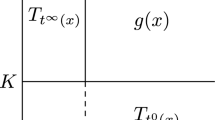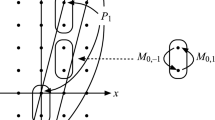Abstract
We show that nontrivial topological and geometric information about configuration spaces of linkages and tensegrities can be obtained using the signature formulas for the mapping degree and Euler characteristic. In particular, we prove that the Euler characteristics of such configuration spaces can be effectively calculated using signature formulas. We also investigate the critical points of signed area function on the configuration space of a planar polygon. We show that our approach enables one to effectively count the critical points in question and discuss a few related problems. One of them is concerned with the so-called cyclic polygons and formulas of Brahmagupta type. We describe an effective method of counting cyclic configurations of a given polygon and formulate four general conjectures about the critical points of the signed area function on the configuration space of a generic planar polygon. Several concrete results for planar quadrilaterals and pentagons are also presented.
Similar content being viewed by others
References
A. Agrachev and R. Gamkrelidze, “Quadratic mapping and smooth vector-functions: Euler characteristic of the level set,” Itogi Nauki Techn. Sovr. Probl. Mat. Noveishie Dostizhenia, 35, 179–239 (1989).
V. Arnold, A. Varchenko, and S. Gusein-Zade, Singularities of Differentiable Mappings [in Russian], Nauka, Moscow (2005).
G. Bibileishvili, “On configuration spaces of planar polygons and graphs,” Bull. Georgian Acad. Sci., 168, 203–206 (2003).
J. Bochnak, M. Coste, and M.-F. Roy, Real Algebraic Geometry, Springer-Verlag, Berlin–Heidelberg–New York (1998).
J. Bruce, “Euler characteristics of real varieties,” Bull. London Math. Soc., 22, 213–219 (1990).
B. Dubrovin, S. Novikov, and A. Fomenko, Modern Geometry [in Russian], Nauka, Moscow (1988).
D. Eisenbud and H. Levine, “An algebraic formula for the degree of a C ∞ map germ,” Ann. Math., 106, 19–44 (1977).
M. Fedorchuk and I. Pak, “Rigidity and polynomial invariants of convex polytopes,” Duke Math. J., 129, No. 2, 371–404 (2005).
G. Giorgadze, “Quadratic mappings and configuration spaces,” Banach Center Publ., 62, 159–172 (2004).
M. Hirsch, Differential Topology, Springer-Verlag, Berlin–Heidelberg–New York (1976).
Y. Kamiyama, “The Euler characteristic of the moduli space of polygons in higher-dimensional Euclidean space,” Kyushu J. Math., 54, 333–369 (2000).
M. Kapovich and J. Millson, “Universality theorems for configuration spaces of planar linkages,” Topology, 41, 1051–1107 (2002).
G. Khimshiashvili, “On the local degree of a smooth mapping,” Bull. Acad. Sci. Georgian SSR, 85, 309–312 (1977).
G. Khimshiashvili, “On the cardinality of a semi-algebraic subset,” Georgian Math. J., 1, 111–120 (1994).
G. Khimshiashvili, “Signature formulae for topological invariants,” Proc.A. Razmadze Math. Inst., 125, 1–121 (2001).
G. Khimshiashvili, “On configuration spaces of planar pentagons,” Zap. Nauch. Semin. POMI, 292, 120–129 (2002).
G. Khimshiashvili, “Circular configurations of planar polygons,” Bull. Georgian Natl. Acad. Sci., 176, No. 2, 27–30 (2008).
A. Lecki and Z. Szafraniec, “An algebraic method for calculating the topological degree,” Banach Center Publ., 35, 73–83 (1996).
A. Pugh, An Introduction to Tensegrity, Univ. Calif. Press, Berkeley (1976).
D. Robbins, “Areas of polygons inscribed in a circle,” Discr. Comput. Geom., 12, 223–236 (1994).
W. Thurston, “Shapes of polyhedra and triangulations of the sphere,” Geom. Topol. Monogr., 1, 511–549 (1998).
V. Varfolomeev, “Inscribed polygons and Heron polynomials,” Sb. Math., 194, 311–321 (2003).
Author information
Authors and Affiliations
Additional information
Translated from Sovremennaya Matematika i Ee Prilozheniya (Contemporary Mathematics and Its Applications), Vol. 59, Algebra and Geometry, 2008.
Rights and permissions
About this article
Cite this article
Khimshiashvili, G. Configuration spaces and signature formulas. J Math Sci 160, 727–736 (2009). https://doi.org/10.1007/s10958-009-9524-x
Published:
Issue Date:
DOI: https://doi.org/10.1007/s10958-009-9524-x




